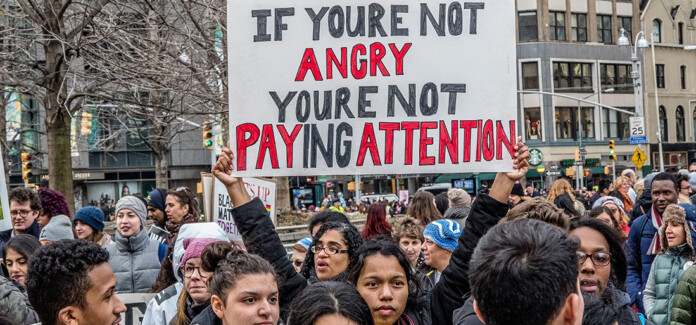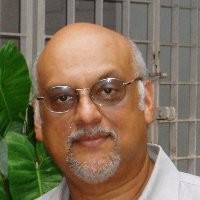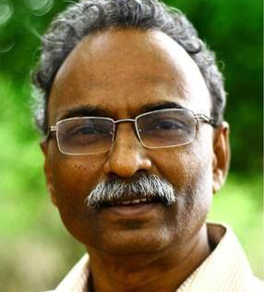Chennai-based Rathindra Nath Roy reflects on how communication on climate change needs to be bottom-up, not elitist, in a chat with Hari Haran Chandra
What do you do when you have spent several decades successfully facilitating and steering many organisations in the development sector worldwide and realise that your effort has not meant much when it comes to impacting the next-door neighbour on simple things that either reduce consumption or make for better ecological footprint?
Rathindra Nath Roy has wrestled with this challenge for some years, in between times, as he says, ‘when he is not trying to retire and learn the art of doing nothing’. He has for long been an independent facilitator working with UN agencies, development organizations, enterprises, civil society and communities interested in innovation and creative problem solving for livelihoods and lifestyles that reduce consumption and ecological footprints, food sovereignty and governance systems that are mindful and that actually work.
He is from the finest stock as professionals go in India. He read electrical engineering, public health and political science at the IIT, Madras and the University of Miami in Florida. As a researcher and development practitioner he worked with the Gujarat Institute of Development Research, and the Murugappa Chettiar Research Centre back home in Chennai. Over his years, he advised the Swedish International Development Agency on social and community forestry efforts and spent many years facilitating management of small-scale fisheries as a senior professional with the Fisheries Department of the Food and Agriculture Organization of the UN. He sees things from the bottom of the heap, understands the pains and pangs of fisherfolk or of those who live in what we call slums.
How do you benefit the poor, I ask him. How do you take innovative products or ideas to the rural poor? Or for that matter how do you enable value chains to help farmers reach markets? How do you bring reconciliation using dialogue, visual thinking and sketch-noting, calligraphy, gardening, cooking and what can be best described as the archaeology of the ordinary?
Says Rathindra, “One of my concerns is, when we talk about climate action or climate change and environmental issues, our connectedness, interconnectedness and interdependence with nature is hardly talked about. We know it is a complex global problem, which make it all the more difficult to reduce it to simplicity. When an institution has to work, when bureaucracies have to work, they have to be able to communicate things. Sometimes it is about things to do, other times it is about things to pay for; who should do what. They have to be able to do it with the agility and guile that is needed to go up and down the bureaucracy and sideways in the bureaucracy.”
What gets done in the government or in industry are things that are easy to talk about. City ratings is one good example. The Cleanest City in India, the greenest building in a city …. people seem to love ratings because it is easy to simplify extremely complex things to a nice number and then you can get the PR machinery to take it to social media. We do it because it is a twitter thing to do.
Take the climate change discussion and discourse. It still remains elitist. It’s happening among scarily small numbers of people, and among people who have a language of their own. When the ‘expert’ talks about climate change, says Rathindra, “I can easily confess to you the number of words that I’m not really clear about. And it’s not because of a lack of education. I genuinely don’t know what is being talked about and the more I talk with, ‘experts’ I realise, to my horror and dismay, that they don’t know what they’re talking about either.”
Rathindra pauses, searching for the right thing to say, “It’s an agreed-to concept that is being shared around, you know, and there are hundreds of it when it comes to climate change all the way from words which have become absolutely common like ‘sustainability’. Over 40 years of work. I haven’t come across anyone who has clarified to me, how on earth you measure sustainability! What is it anyway? How do we measure it? How do we understand it in a complex system?
Does Awareness Leads to Change?
Does awareness and knowledge lead to change? Rathindra looks quizzically, “Ah, I have asked that question often in my own life. Take my personal behaviour. I have a degree in public health. I know a hundred reasons why I shouldn’t smoke, yet I did for a very long time. I had excellent reasons that I convinced myself upon on why I should be smoking. I’m not saying we should not make an effort to get a deep understanding of causes and reasons. I think we need to ask ourselves, So what does it mean?
“How do people understand these things inside their heads? Take water and usage. We are one of the most water inefficient when it comes to agriculture. Thanks to high science, not low science, and the choices India made in the 1960s and 1970s, we have a legacy that seems impossible to get over when it comes to cultivation.
When it comes to our cities, and water, and the cost of energy that water brings, we ignore the challenge. We are driven by convenience. We choose transportation or water technologies and systems, or energy purely on the basis of convenience. We are willing to pay for it because we want convenience. We want to save time. We want to save our personal effort and energy. And when it comes to play as a primary decider, we hit those inevitable challenges of abuse and excessive use of precious natural resources.
“Let us accept that it’s very difficult to talk about any city- or country-wide problem, unless a lot of people start doing things or acting in a prescribed way. We saw how it worked in the initial weeks of the Covid scare when the country was brought to a halt. Scare worked. We saw the real benefits. We saw the Ganga in Kanpur running clean, or the Jamuna in Delhi. So what does it take for the bureaucrat to come down on those polluters along the rivers?
“There is a larger aspect that we should be concerned about. Not only should you be changing as an individual or as a collective of people, but you have to encourage others to change because if they don’t change and you change, it’s not enough. You could say that of the spread of the Corona virus or, well, of the use of water or energy or how you generate or manage waste in homes, offices, hotels, hospitals or industry.
Simplify Language
“Two things which might slow us down a little bit, and offer our cities a better chance. One is about how we use language to understand the peculiarities and the nature of climate change and environmental degradation, not in a scientific sense, but in a way that the rickshaw puller, the school child, the slum dweller, the fisherman and his family, and the lifestyle denizen who uses 80 percent of all resources that a poor urban citizen uses. Why is it so difficult to pretend to be predictable in a system that is basically unpredictable?!”
It is amazing that rapidly over the last 5 to 7 years we have technologies for reducing freshwater use and grid energy demand for your home or office by as much as 70 percent. What’s more, they are available at costs that offer returns that you can dream of earning in any business.
Rathindra goes on quietly, as he leans forward in his chair, “How do we unravel these with stories that make it easy for the lay person to understand? How do we get the expert to stop talking to other experts, and start reflecting on how to reach out to those who ‘do not understand it’? Their ability to understand what people are talking about becomes much easier with stories, with little things they can relate to in their everyday lives.
“Well, the second key concern I have zoned down upon in my understanding is to with the inequities we have built into our system – economically, politically, socially. They aggravate the essential problem of the resource crisis by making acceptance so much more difficult. It makes it almost impossible to do these things. First we have to build narratives, where we all begin to understand not the jargon that’s tossed around, but what it really means to people every morning as they live out their day, as they commute, as they work. That will lead us to ask ourselves what can I do today to make a difference.
Hari is a Trustee at INHAF, Prem Jain Memorial Trust, AltTech Foundation and a Senior Fellow at the Indian Green Building Council. He can be reached at hari1degree@gmail.com.












